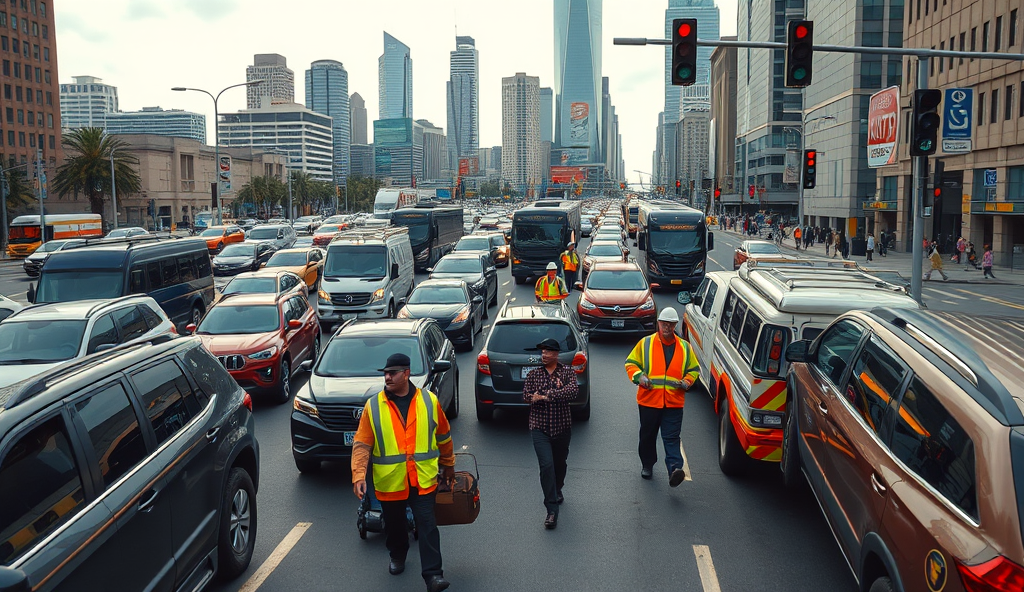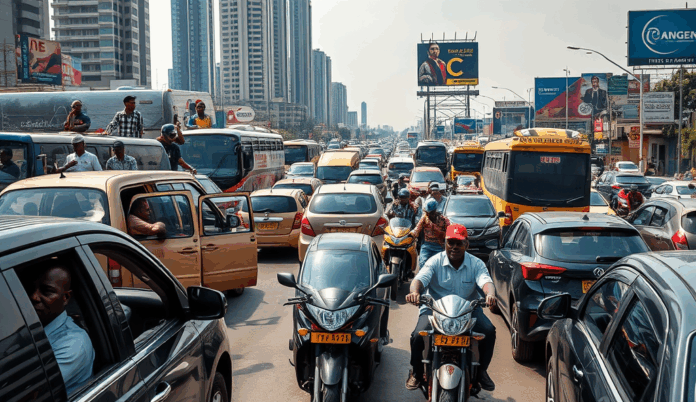Introduction to Traffic Gridlock in Lagos
Lagos, Nigeria’s economic hub, faces severe traffic gridlock daily, with commuters spending an average of 3 hours in transit during peak periods. The city’s rapid urbanization and population growth, now exceeding 20 million, have outpaced road infrastructure development, worsening congestion.
Key routes like the Third Mainland Bridge and Apapa-Oshodi Expressway often experience standstills due to high vehicle density and poor traffic management. These bottlenecks not only delay commuters but also cost Nigeria’s economy an estimated ₦4 trillion annually in lost productivity.
Understanding these challenges is crucial for navigating Lagos’ roads efficiently, which we’ll explore further by examining the root causes of traffic gridlock next.
Key Statistics

Understanding the Causes of Traffic Gridlock in Lagos
Lagos commuters lose an average of 3 hours daily in traffic with 65% reporting increased stress levels and reduced productivity due to prolonged gridlock.
Lagos’ traffic gridlock stems from rapid urbanization, with the city’s population growing by 600,000 annually while road networks expand at just 0.5% yearly, creating severe bottlenecks. Poor urban planning exacerbates congestion, as 70% of daily trips concentrate on just 30% of roads, particularly the Third Mainland Bridge and Apapa-Oshodi corridor.
Inadequate public transport forces over 5 million commuters to rely on private vehicles, with Lagos having only 200,000 registered buses for its 20 million residents. The absence of efficient mass transit systems like rail or BRT networks in most areas further strains existing road infrastructure during peak hours.
Poor traffic management and rampant disregard for traffic laws contribute significantly, with 40% of congestion caused by illegal parking, danfo drivers’ indiscipline, and lack of enforcement. These systemic issues collectively worsen Lagos’ urban mobility crisis, directly impacting commuters’ daily lives, which we’ll explore next.
Impact of Traffic Gridlock on Commuters in Lagos
Strategic timing can significantly reduce exposure to Lagos traffic congestion problems with data showing 6:30-7:00 AM and 10:00-11:30 AM as optimal windows for eastbound commutes.
Lagos commuters lose an average of 3 hours daily in traffic, with 65% reporting increased stress levels and reduced productivity due to prolonged gridlock. The economic toll is staggering, costing Nigeria’s commercial hub an estimated ₦4 trillion annually in lost man-hours and fuel consumption.
Healthcare workers, teachers, and corporate employees frequently arrive late, with 40% of businesses reporting decreased output due to staff delays. The Apapa-Oshodi corridor alone sees over 10,000 missed appointments daily as commuters struggle with unpredictable travel times.
These challenges highlight the urgent need for strategic travel planning, which we’ll explore in the next section on optimal travel times.
Best Times to Travel to Avoid Traffic Gridlock in Lagos
Commuters heading eastbound can use the Freedom Road link from Lekki Phase 1 to avoid the Ajah bottleneck saving up to 35 minutes during peak periods according to recent Waze traffic data.
Strategic timing can significantly reduce exposure to Lagos traffic congestion problems, with data showing 6:30-7:00 AM and 10:00-11:30 AM as optimal windows for eastbound commutes along the Lekki-Epe corridor. Late evening trips between 7:30-9:00 PM also show 40% faster movement on major arteries like Ikorodu Road compared to peak hours.
For westbound routes including the Third Mainland Bridge, early departures before 6:00 AM or late returns after 8:30 PM help bypass the urban mobility crisis in Lagos, reducing travel time by up to 55%. Fridays typically see heavier congestion from midday onward as weekend travelers compound regular commuter volumes.
These time-sensitive strategies create opportunities to explore alternative routes to bypass traffic gridlock in Lagos, which we’ll examine next for comprehensive route optimization. School runs and market days particularly distort traffic patterns in areas like Surulere and Mushin, requiring adjusted schedules.
Alternative Routes to Bypass Traffic Gridlock in Lagos
Lagos' BRT buses transport over 200000 daily commuters along dedicated lanes cutting travel time by 40% on congested corridors like Ikorodu Road according to LAMATA's 2023 ridership report.
When timing adjustments aren’t feasible, strategic detours through less congested arteries can help navigate Lagos’ urban mobility crisis. Commuters heading eastbound can use the Freedom Road link from Lekki Phase 1 to avoid the Ajah bottleneck, saving up to 35 minutes during peak periods according to recent Waze traffic data.
Similarly, the Herbert Macaulay-Yaba bypass offers relief for mainland-bound travelers avoiding Third Mainland Bridge congestion.
For western routes, the Agege Motor Road and Iju-Ishaga corridors serve as viable alternatives to Ikorodu Road, particularly on market days when Mushin experiences severe gridlock. GPS data shows these detours reduce travel time by 25-40% between 7:30-9:30 AM compared to primary routes.
Motorists should note these alternatives often have narrower lanes but consistent movement.
Exploring these secondary routes complements the previously discussed timing strategies, creating a comprehensive approach to beating Lagos traffic. As we’ll examine next, combining route alternatives with public transportation options further enhances commuters’ ability to navigate the city efficiently.
Local knowledge of neighborhood shortcuts in areas like Surulere proves invaluable when primary arteries clog.
Public Transportation Options to Reduce Traffic Gridlock in Lagos
Smart traffic management systems now optimize Lagos' busiest intersections with adaptive signal controls at 28 junctions reducing wait times by 30% during peak hours according to LAMATA's 2022 efficiency report.
Lagos’ BRT buses transport over 200,000 daily commuters along dedicated lanes, cutting travel time by 40% on congested corridors like Ikorodu Road according to LAMATA’s 2023 ridership report. The expanding blue rail line now serves 50,000 passengers daily between Marina and Mile 2, with plans to extend to Okokomaiko by 2025 to further ease mainland traffic pressure.
Ferry services provide efficient alternatives for lagoon-adjacent commuters, with the Ikorodu-Falcon route reducing typical 3-hour road trips to 45 minutes during rush hours. Ride-sharing platforms like Plentywaka and Shuttlers offer premium bus services with real-time tracking, complementing traditional danfo routes while providing predictable schedules for professionals.
These mass transit solutions integrate with the route alternatives discussed earlier, forming a multi-modal approach to Lagos’ urban mobility crisis. As we’ll explore next, emerging technologies are enhancing these systems’ efficiency through smart traffic management and payment solutions.
Role of Technology in Managing Traffic Gridlock in Lagos
Smart traffic management systems now optimize Lagos’ busiest intersections, with adaptive signal controls at 28 junctions reducing wait times by 30% during peak hours according to LAMATA’s 2022 efficiency report. Digital payment solutions like Cowry Cards streamline boarding for BRT and ferry services, processing over 500,000 daily transactions while eliminating cash-related delays.
AI-powered platforms like TraffikAnalytics provide real-time congestion alerts, helping commuters reroute through less crowded alternatives mentioned earlier, while ride-hailing apps integrate traffic data to suggest optimal pickup points. These innovations complement the multi-modal transport network by enhancing operational efficiency across all connected systems.
As technology reshapes urban mobility, government policies play an equally critical role in sustaining these advancements, which we’ll examine next regarding infrastructure investments and regulatory frameworks. The integration of tech solutions with physical infrastructure demonstrates Lagos’ progressive approach to tackling its urban mobility crisis.
Government Policies and Initiatives to Tackle Traffic Gridlock in Lagos
Building on Lagos’ tech-driven mobility solutions, the state government has implemented policy frameworks like the Lagos State Transport Policy (2018) to standardize operations across all transport modes, including BRT, ferries, and ride-hailing services. The ongoing Blue and Red Line rail projects, expected to move 500,000 daily passengers by 2025, demonstrate strategic infrastructure investments to alleviate urban mobility crisis in Lagos.
Regulatory measures such as the 2003 Lagos Road Traffic Law and its 2018 amendment enforce traffic discipline through dedicated agencies like LASTMA, which deployed 2,500 officers across critical corridors to manage peak hour traffic jams in Nigerian cities. These policies complement the smart traffic systems mentioned earlier by creating an enforceable structure for road usage and public transport operations.
The government’s multi-agency approach integrates LAMATA, LASDRI, and private sector partners to address road infrastructure deficiencies in Nigeria, with over ₦50 billion allocated annually for road rehabilitation and transport upgrades. As these systemic solutions take effect, individual commuters can further optimize their journeys through personal strategies we’ll explore next.
Personal Strategies for Commuters to Avoid Traffic Gridlock in Lagos
While government initiatives address systemic issues, Lagos commuters can adopt practical strategies like using real-time traffic apps (e.g., Google Maps or GoLAG) to bypass congestion hotspots, with data showing these tools reduce travel time by 20-30% during peak hours. Alternating work schedules or leveraging flexible hours can help avoid the 7-9am rush when 60% of Lagos’ workforce hits the roads simultaneously.
Exploring alternative routes like the Third Mainland Bridge’s less congested Ebute Metta axis or opting for water transport via LAGFERRY services (which move 4,000+ passengers daily) provides viable options during gridlock. Carpooling through platforms like Rida and Plentywaka not only cuts costs by 40% but also reduces vehicle volume on major corridors like Ikorodu Road.
Adopting multimodal commuting—combining BRT, ride-hailing, and walking—can optimize journeys, as demonstrated by Victoria Island professionals who save 1.5 daily hours using this approach. These individual efforts, when combined with community-driven solutions we’ll explore next, create a more sustainable mobility ecosystem for Lagos.
Community Involvement in Reducing Traffic Gridlock in Lagos
Neighborhood associations in areas like Lekki and Surulere have successfully implemented traffic management schemes, with volunteer wardens reducing peak-hour congestion by 15% through coordinated intersection control. These grassroots efforts complement digital solutions like GoLAG and carpooling platforms mentioned earlier, creating a multi-layered approach to Lagos’ urban mobility crisis.
Residents’ advocacy groups have pressured local governments to repair critical roads like Oshodi-Apapa Expressway, while community-led car-free days in Ikeja demonstrate how behavioral shifts can ease Nigerian road transport challenges. Such initiatives prove that collective action can amplify individual strategies like flexible work hours and multimodal commuting.
As these community-driven solutions gain momentum, they lay the groundwork for systemic improvements we’ll examine in the final section—where policy meets public participation to redefine Lagos’ transportation future. The synergy between personal adaptations and organized local action offers a blueprint for sustainable change.
Conclusion: Moving Forward to Solve Traffic Gridlock in Lagos
Addressing Lagos traffic congestion problems requires a multi-pronged approach, combining infrastructure upgrades, smarter urban planning, and behavioral changes among commuters. The Lagos State Government’s ongoing Blue and Red Line rail projects, expected to transport over 500,000 daily passengers, demonstrate the potential of mass transit systems in easing urban mobility crises.
Public-private partnerships could further alleviate Nigerian road transport challenges by modernizing bus fleets and expanding ride-sharing options. For instance, the success of Lagos Ride shows how tech-driven solutions can complement traditional transport systems while reducing peak hour traffic jams in Nigerian cities.
Ultimately, solving the economic impact of traffic gridlock in Nigeria demands sustained collaboration between policymakers, businesses, and citizens. By adopting the strategies discussed—from alternative routes to flexible work hours—Lagos commuters can collectively transform the city’s transportation landscape.
Frequently Asked Questions
What are the best times to travel on Lagos roads to avoid traffic gridlock?
Opt for 6:30-7:00 AM or 10:00-11:30 AM eastbound and before 6:00 AM westbound – use Waze for real-time updates.
Which alternative routes can help bypass Third Mainland Bridge congestion?
Try Herbert Macaulay-Yaba bypass or Agege Motor Road – these save 25-40% travel time during peak hours.
How effective are Lagos BRT buses in reducing commute times?
BRT cuts travel time by 40% on routes like Ikorodu Road – get a Cowry Card for faster boarding.
What tech tools can help navigate Lagos traffic gridlock?
Use TraffikAnalytics for congestion alerts or GoLAG app for real-time alternative route suggestions.
Are ferry services a viable option for Lagos commuters?
Yes – the Ikorodu-Falcon ferry route reduces 3-hour road trips to 45 minutes – check LAGFERRY schedules.


